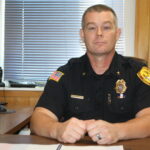No story of a community would be complete without a mention of some of the great disasters which have befallen it; for without obstacles to overcome, its character would not be what it is today.
Disaster came to Caribou the first week of January in 1954. Flames and death ushered in the New Year as a raging holocaust took the life of one person and reduced the Vaughan House to a mass of smoldering ruins. It was a $100,000 blaze. Five Days Later
And a scant five days later another great blaze destroyed the Holy Rosary Catholic Church for the second time within 20 years.
Fire Chief Don Woods had reported that just before the Vaughan House destruction that fire losses for the fiscal year beginning Feb. 1, 1953, had totaled less than $50,000. Within the five-day period, the fire loss to the town had increased 600 percent.
Hundreds of merry makers and guests fled the Vaughan House early that Friday morning, but Carl Robinson of Portland did not. He was apparently trapped by flames and smoke.
A Landmark
Much of the early history of the Vaughan House and the Catholic Church were recorded in the Aroostook Republican by Joyce Marden Anderson, who was news editor at that time. Excerpts from her work follows:
“The Vaughan House had been a landmark in the town since the days of the early settlers. It had long served as a meeting place of Caribou service club and civic groups, and many a distinguished guest had delivered addresses at banquets in its dining room.
“The original hotel was erected on the same site in 1860 by Washington A. Vaughan, one of the original settlers of Caribou and the town’s first postmaster. It was completely destroyed by flames on the morning of July 5, 1863, originated by enthusiastic celebrators of Independence Day. It was immediately rebuilt by Vaughan, and its graceful dormered roof and landscaped grounds made it a beauty spot of the town.
“On January 16, 1905, fire again claimed the Vaughan House in a spectacular blaze. Financial loss to the owner, Charles Merrill, was estimated between $9,000 and $15,000. Merrill erected an entirely new hotel almost immediately, but within a year flames again destroyed part of it. The owner again rebuilt, enlarging the hotel and giving it a flat roof and oblong shape which it retained until the 1954 fire.”
Less Than Three Hours
“Ownership of the hotel had passed through many hands through the intervening years until November of 1944, when 45 stockholders formed the Caribou Hotel Corporation and bought the Vaughan House from Walter T. Day. The corporation still owned the hotel when it was destroyed again.”
The flames had started beneath the cocktail lounge of the hotel and in a matter of minutes spread to the second story rooms. Huge clouds of smoke enveloped the rest of the building. The sub-zero temperatures that morning left a coating of ice on trees surrounding it and weighted its walls, contributing to their collapse. In less than three hours the Vaughan House was gone.
Fire Losses $311,800
No less discouraged and saddened than the stockholders of the Caribou Hotel Corporation were the members of Holy Rosary Parish when fire claimed the church, bringing Caribou’s fire loss to $311,800.
And again from the records:
“The main auditorium and chancel of the church were completely gutted by the blaze; however the basement and hardwood floor of the building remained unscathed.
“An explosion had been heard by neighbors that Tuesday morning, but it was the opinion of Fire Chief Don Woods that the explosion did not cause the blaze but was a result of it. He said they were fire explosions caused by oxygen meeting smoldering flames, and it was only then that the fire was discovered.
Dedicated in 1935
“The new Holy Rosary Church was formally dedicated July 21, 1935, almost a year to the day when it was destroyed by flames on July 19, 1934. Delivering the English sermon on that day was the Rev. Daniel Feeney, then of Presque Isle, later to become Bishop of Maine.
“Evacuations for the foundation of the building started in August, 1934, and the superstructure was begun in September. The new church was first used Dec. 16, 1934. Its 16th century, Central European lines were designed by Edwin T. P. Graham, architect. The main auditorium of the church seated 870. It was the largest church in town.
“The original Holy Rosary Church, which was likewise destroyed by flames, was constructed in 1884 and 1885. The first Mass was celebrated by the Rev. C.O. Gingras on May 26, 1886.”
Determination There
Caribou had suffered a tremendous blow within that first week of January; but the spirit and the determination of its people was still there. The town would have a new hotel, and the Catholic parish would have a new church.
A new hotel corporation was formed and stocks were sold. Money and pledges began to trickle into the coffers of the church, slowly at first, but gaining in momentum as its clergy and lay leaders worked untiringly for a new church.
Both the impressive brick Hotel Caribou of today, and the magnificent new larger than ever Catholic Church are ample evidence of the determination and character of the townspeople of Caribou, who have risen above not only these but many other great misfortunes as well.
Presque Isle, ME
17
Clear
Houlton, ME
20
Clear
Caribou, ME
18
Clear
Fort Kent, ME
18
Clouds
Change Location
- Presque Isle
- Houlton
- Caribou
- Fort Kent
© 2024 Bangor Publishing Company.







